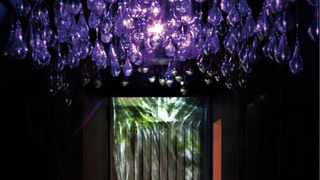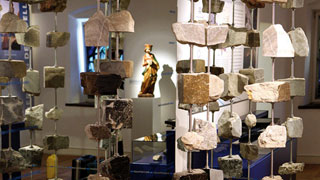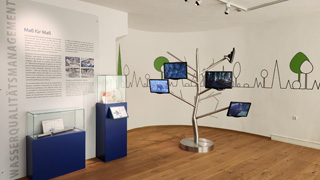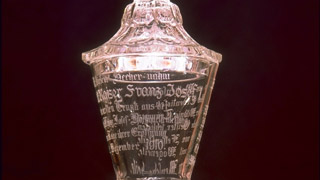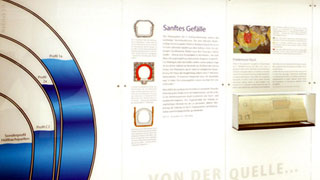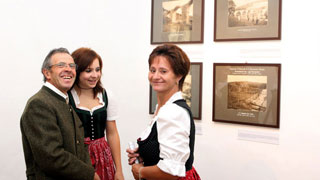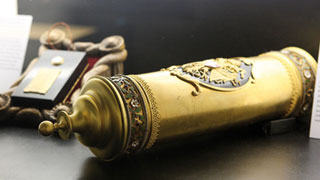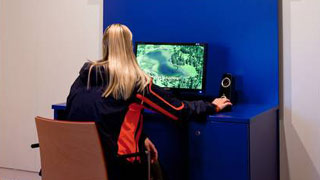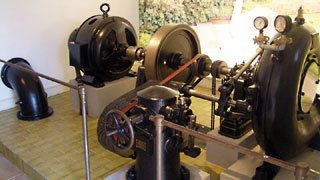Visiting the SpringWater Museum
The SpringWater Museum Wildalpen is composed of the Rooms 1 to 9 featuring the document collection, the Fahrerhof, the Wagnerhaus, the Folk Museum and the Parish Museum. The Museum Cinema seats up to 65 visitors and offers a film with background information about the Museum and its exhibits.
Room 1: Inside the Mountain Spring Pipeline
Visitors cross a replica of the gallery profile and thus get an all-around sensory experience of the conditions prevailing inside the Mountain Spring Pipeline.
Room 2: Geology
In addition to impressive aerial imagery, the drainage function of karst mountains - which is essential for water supply - is visualised with multimedia technology in this room. The geological structure of the Hochschwab Massif including the "innards" of the mountain is interestingly presented and also made a tactile experience by means of rocks from the mountain.
Room 3: Spring Protection Ensures Water Quality
Visitors are informed about the different types of springs harnessed to feed the Second Vienna Spring Water Main. Short films provide an overview of the comprehensive measures taken to protect these resources. Water quality management methods of the past and present are explained and contrasted.
Room 4: Crystal-clear Water
When entering this room, visitors immediately notice the clear spring water gushing from a fissure behind a mirrored wall. The showpiece of this room is the crystal goblet from which Emperor Francis Joseph I drank the first sip of Hochschwab water at the inauguration ceremony of the Second Vienna Spring Water Main, held on 2 December 1910.
Room 5: Vienna's Water Supply Today
This room visualises the current activity range of the Vienna Water. In addition to explaining the key technical components of the Mountain Spring Pipeline, such as galleries, aqueducts and culverts, an overview of the various maintenance procedures required for the Mountain Spring Pipeline is given as well.
Gallery and pipe profiles rendered as silhouettes at a scale of 1:1 convey a precise idea of the dimensions of this long-distance transport line and the extensively ramified pipe network.
Room 6: Period Images
Original period photographs taken by the engineer Luigi Faccanoni illustrate the manifold and difficult work phases that were necessary to implement this titanic project.
Room 7: Construction History
A richly carved wooden ceiling provides the first indication of the construction history. In a video, planner and chief supervisor Karl Kinzer "recounts" the construction of the Second Vienna Spring Water Main.
Among the many exhibits, we find an original specimen of the surveying instruments used at the time to symbolise the remarkable achievements of surveying technology. In addition, a gilt document case recalls the groundbreaking ceremony on 11 August 1900.
Room 8: Interactive Media Library
Two interactive stations enable interested visitors to access information individually, with many different themes to select, from the global water cycle to Vienna's water supply. Moreover, numerous videos for younger and older visitors can be watched as well.
Room 9: Energy Generation, Water Metering, Museum Education
A complete set of units for a functioning water pipeline power station explains how energy is generated from drinking water. Moreover, a water meter indicates how much water flows from a water pipe per minute and gives the price of this water volume.
Other Rooms
The Fahrerhof, the Wagnerhaus, the Folk Museum and the Parish Museum can likewise be visited. At the Fahrerhof, a 3-D film entitled "Der Weg des Wassers" (The Journey of Water) is shown, while visitors will gather interesting information about the interactions of forest and water at the Wagnerhaus, which also boasts a playroom for children. Another six rooms are used by the Folk and Parish Museum.
City of Vienna | Vienna Water
Contact form

